October 14, 2015, Reid Hyle’s Thoughts on the New SES 2G
Definitely put the new SES on your short list if you are a medium sized paddler looking for a new ride. There isn’t much need to go over a lot of detail about what has been changed from the original SES to the new and improved SES. Wesley Echols’ review https://surfskiracing.org/2015/06/new-2015-stellar-ses-surf-ski-review/ already does that. But I will give my impression of the improvements and contrast them with the original SES; and I do think that all of the changes are improvements. This is an awesome boat for me at 5’9” and 165 lbs.
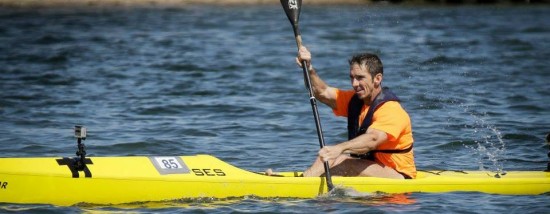
Reid Hyle 1st Place at L2L 2013 in SES 1G.
At this point I’ve been paddling the new SES in the Excel layup since June which means that it has mostly be very hot and very flat here in Florida. So I held off on writing up an assessment until I felt like I had enough times in waves to get a good feel for the boat. I have been able to get out and do out and back repeats when a good sea breeze has the ocean white-capping in the afternoons. That means that my rough water time in the boat is in and out through surf plus repeats of 5-20 minutes paddling upwind and surfing back to start in short steep and sometimes pretty chaotic ocean waves. The cockpit is immediately comfortable for me. I put the footplate where I wanted it and have had to do nothing else except the half inch of soft foam I like to sit on in any boat that I paddle.
Flatwater speed is the same or slightly better than the original SES. The narrower catch feels more ergonomic and the boat does not squat at all at 8+ mph. The better trim should translate into better speed. Time trials are pretty useless in this heat but my cruising pace is excellent at low perceived exertion. The speed in the SES is same as in my K1s when just cruising along at a heart rate of 135 or so. Stability feels the same to me. I took my ½” pad out of my old SES and put it straight into the new when I swapped out boats and had no issues. This is in contrast to the Nelo Ocean Ski or my old Fenn Mil in which padding takes me a little getting used to in confused water.
The New SES being narrower above the waterline in the forward section may have taken a little secondary stability away as a trade for better paddling ergonomics but I can’t really feel any issues. This is a paddle anywhere in any condition boat for me and was so straight out of the wrapper. The bulkhead being moved back and the cockpit being a tad narrower improves the fit for me and reduces the volume of water that the cockpit collects when punching out through surf. Consequently, the boat looks better and drains a lot faster. This is a huge improvement over the first generation. I spend a lot of time in and out of surf since I always launch off the beach and generally only when it is breaking. No single-footwell adjustable ski is going to drain like the old high-hump double-footwell fixed length surfskis but SES is now in line with the other open water skis for the amount of water it takes on and how long it takes to clear that water.
The new SES holds a line better in side wind. I think this is a combination of the change in the front deck coming further back and the rudder being moved forward. The old SES wanted to swing straight downwind and took a bit of rudder input or boat lean to resist. The new SES is about as close to neutral in a side wind as you want a surfski to be. Downwind handling is really sweet. The rudder placement makes the boat more responsive and the bucket being moved slightly forward makes the boat want to drop in a little easier. I was a little worried that moving the bucket forward would make the boat want to nose-dive but that has not been the case. It might be an issue if I was over 180lbs like I once was but at my height and weight the center of buoyancy seems about perfect. All the waves I’ve been in have been disorganized STEEP 1-3 foot wind slop in the ocean and the boat just goes wherever you think it to go. It might be better going upwind. The narrower forward section above the waterline should translate into better upwind performance but there’s no good way to standardize a comparison and paddling upwind should be avoided anyway.
I might have more information about this when the northers blow in a couple of months and I get out in waves of 4-6 feet and 5-6 seconds. Other than the improved paddling characteristics, the little added features work as well. The added handles are nice. It is nice to have something on the end to grab whether carrying or swinging the boat into a sea when swimming. I haven’t tested the swimming part yet though. I actually do use the water bottle holder. It is really convenient to just slap a bottle in the holder rather than fussing with a drink bag and tubes for short 60-90minute paddles in the morning before work. Having the bottle in the cockpit is better than having to reach over the foot plate to grab a loose bottle or reach back to grab a bottle from under the bungies on the back deck. I’ve lost a lot of bottles getting flung out of the open cockpit when paddling out over waves. I’ve had waves rip bottles out from the back deck bungies. I haven’t lost a bottle out of the bottle holder.
In summary, this is a great boat. Stellar had a great hull in the original SES. Stellar did the right thing by keeping what worked on the original SES, the speed/stability/volume, and improving just about every area about which paddlers had provided feedback.
Wesley’s Review of the New 2015 Stellar SES Surf Ski.
Since paddling surf skis in 2003 and reviewing over 45 surf skis(different models, same model different layups), most of which are on this site, I have seen many changes in the manufacturing, design and marketing in the industry that I have been a part of. For the record I reviewed many surfskis before I began working for Stellar USA in 2009 when I helped launch the Stellar Surf Ski brand during 2009 to 2013. I left Stellar for about a year before rejoining Dave Thomas, Ed Hofmeister co-owners and designers of Stellar Kayaks and Surfskis. During my time away, I reviewed another 10 surf skis in 2014. However in January 2015 I rejoined the Stellar Team as the Performance Director for Stellar USA while still working my full time job in pharmaceutical sales, running this site, and consistently training for races. Yes, I am very busy as you might imagine but that keeps things fun and exciting for me. I am happy to be back at Stellar USA still trying to grow the sport as I have always done with this site, while helping paddlers decide on the appropriate boat(s) for their skill level. It just so happens the biggest changes in the industry have coincided with my time at Stellar. Competition can do that. The last six years has seen the most dramatic changes. Below are a few of the major changes.
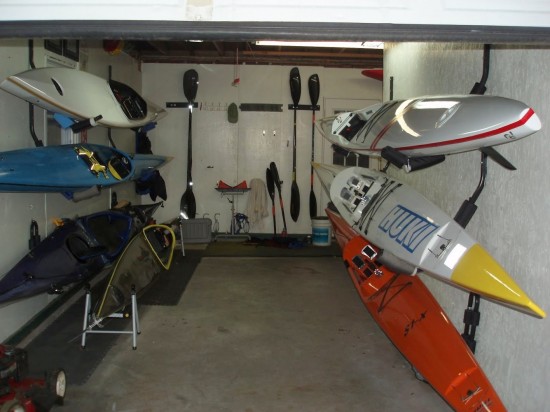
One of my 1st Garage Pics 2004. Far upper left: Jet, Mohican,Rapier, Tor. Right: V10Sport, Huki S1R and Huki S1X with fixed double pedals
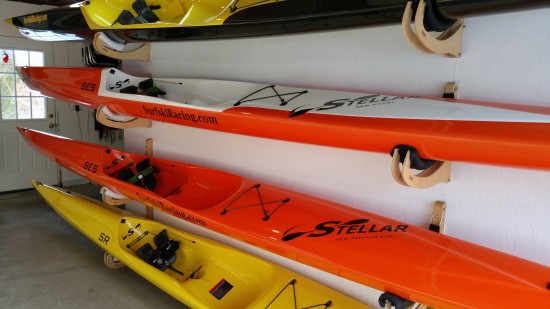
Right Side of Garage May 2015, SES 2011 Ultra, 2015 SES Excel, 2015 Ses Advantage, 2015 SR Excel.
State of Surf Ski Industry
1. Construction of skis across the brands has gotten better with a few exceptions, with Stellar leading the way since it came on the scene in 2010. I clearly remember seeing the prototype SE at the Potato Race in 2009 and doing a walk around while running my hand across the hull. I thought to myself then and now, these are the best built boats on the market. At the May 2015 Stellar Dealer Conference, I was excited to see a demonstration of a CAD design of one of our skis and learned more about the design and manufacturing process of Stellar composite boats. Stellar Kayaks and Surfskis are built using the same design technology, construction processes, and name brand materials that are used to make the number one rowing shell in the world, WinTech Rowing Shells. Both are produced in the same ISO 9001 Certified Manufacturing Facility, Flying Eagle. Ed and Dave designers of both WinTech Rowing Shells and Stellar Kayaks/Surfskis spend a combined 220 days on site in China making sure the quality of the kayaks and rowing shells meet the highest standards.
2. Fit: A surfski to fit everyone: Like the SES is specifically designed for the small to mid size paddler, there is now a ski that fits practically everyone with few exceptions. In the category of low volume surf skis,you now have more choices than ever. This was not the case five years ago. On the opposite end of the spectrum, you have surf skis that can accommodate large and tall paddlers. Before all the current boat choices, I would often see large paddlers squeeze into a bucket that was too tight or tall paddlers with their knees in their chest. These paddlers would wonder why they were having stability issues. No fault of their own, just that the boats were not designed to fit them. Same case with the smaller paddler. Surf skis a few years back were designed for the “average” size paddler. The expansion of the surfski market has remedied this.
3. Surfski for Every Skill Level: Now there is a surf ski for every skill level of paddler from the novice to the expert. A lot of paddlers have more than one surfski for different types of water to maximize their performance. With the novice boats like the Stellar S18S, Think Eze, Epic V8, and Fenn Blue Finn, most sea kayakers can transition easily to one of these skis or a novice paddler can began his paddling career with one of these boats with ample bucket time. In the category of the intermediate skis there are many choices. Stellar just added the new redesigned SR to that category go along with the Stellar SEI, V10 sport, Evo II, Swordfish, Huki S1R to name the most popular ones. From there you get into the intermediate/advanced skis like the Stellar SEL, Huki S1X Special/XL to name a few. At the top end of the speed chart there are more choices than ever including the SES 1G(first generation) and SES 2G. Deciding on a particular surf ski can get overwhelming for many paddlers. So in 2010 I decided to put all my experience with surfskis on a comparison chart as a reference point for paddlers which you can see below. The most current chart is out of date since I have reviewed 10 more skis in 2014 but have not added them to this chart. This summer I will add the new SES and SR along with the other skis.
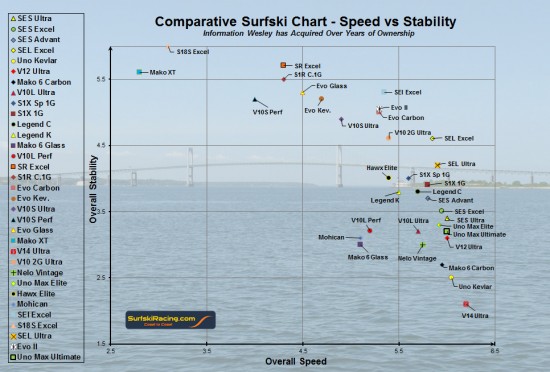
Jan 2014 Chart. Must add S1X Special 2g, S1XL, Ion, Eze, Evo2 Carbon, SR, SES15, Glide, Spark
4. Participation: Five years ago, kayaks were the biggest class of any race, but now the surf ski class draws the largest field in most races. This is in part due to the features above and a few more benefits that skis have over kayaks, namely being lighter weight, having more efficient hulls, generally safer, and the promotion of surf skis for fitness, racing, and general enjoyment. I am proud to say we had 87 surf skis at the 2014 East Coast Surf Ski Championship(L2L). https://surfskiracing.org/2014/09/l2l-east-coast-surfski-championship-hot-success/
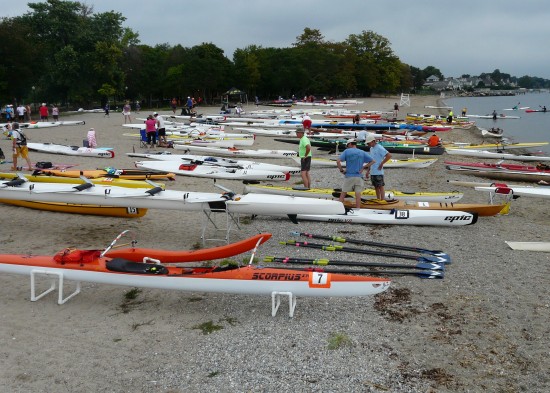
2014 East Coast Surfski Championships. 87 skis total enter for 7/14 mile course!
1st Generation Stellar SES
The first generation SES that I reviewed back in 2010 was the very first low volume surfski in the industry to be built hydrodynamically and ergonomically for the small to mid size paddler. It was not just a copy of a larger skis with cockpit changes. See my October 2010 Review of the first SES.
https://surfskiracing.org/2010/10/stellar-ses-review-by-wesley-echols/
Since 2010, I have paddled the SES in various layups more than any other of my skis. Why?
1) It is sized correctly for me. When I started paddling the SES I was 168 and now I am 178. The ski at 20ft 4 inches and 16.6 inches in the beam(the most narrow beam of any ocean ski) feels right.
2) Personal Records. If I look back over my career racing, my best times were in the SES from flat water to ocean with few exceptions(Mohican,pure flat water) or Stellar SEL.
3) Affiliation with Stellar (I had more Stellar boats available to me). I raced many other brands of skis however, my best times again were in my SES or SEL.
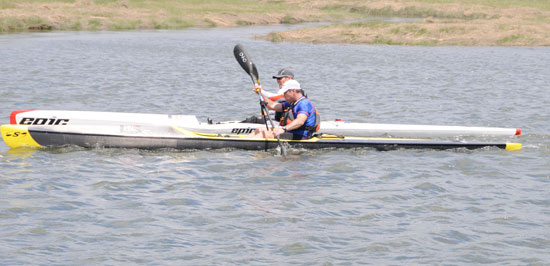
2010 Essex River Race tied for 1st with training partner on windy day blowing 25 on the beam the whole race.
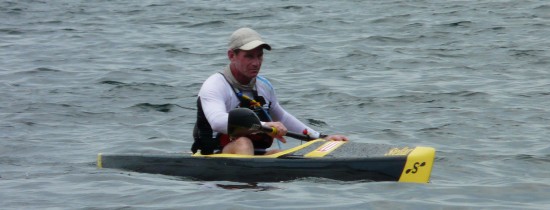
Blackburn 2011, a PR 2.49.55 on a hot day.
2nd Generation (2G)2015 SES
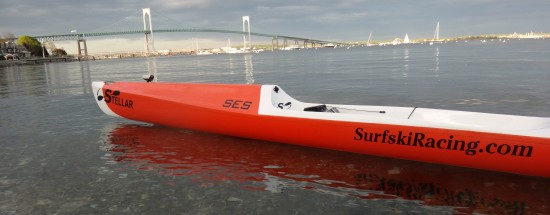
2015 Stellar SES Excel (24lbs) with Newport Bridge in Background. This is one our favorite launch sites. Water is most often uneven and requires your attention.
The 2nd Generation(2G) 2015 SES which I have paddled off and on since January 2015 has many updates since the SES 1G rolled off the production line in 2010. Click on the Stellar Kayaks and Surfski website for an overview of the 2015 SES. Click on the Featured Tour on the SES page. Since I reviewed the 1G SES five years ago, we have had a lot of customer feedback from across the globe on what paddlers wanted improved in the 2G, including myself. We wanted a more comfortable bucket with a more tapered footwell with a better turning radius/steering, narrower catch, and better draining with the ability to drop “in” on a wave more readily. Below is how we addressed these changes and more.
http://www.stellarkayaksusa.com/ses.html
Design Changes
1. Rudder moved slightly forward in 2G to improve steering, turning radius, and tracking. Often I would lose a boat length on a buoy turn in the 1G to competitors. The 2G SES turns significantly better and is more responsive on the wave. I was pleasantly surprised how well the 2G SES tracks both downwind and how easy it is to ride the side wash another paddler in the ocean and flat water with minimal effort.
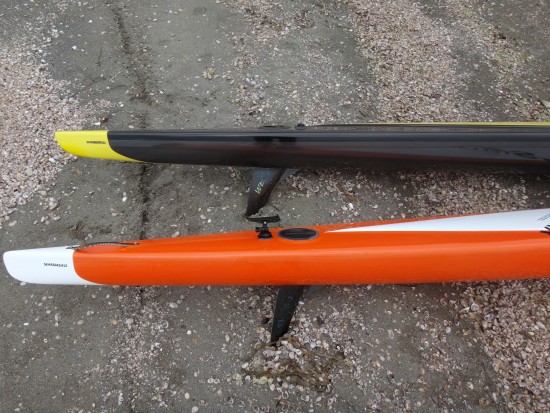
Rudder moved slightly forward for better steering
2. Cockpit moved forward slightly to enhance dropping in on a wave and handling.
3. Cockpit is better shape(rounded) now, and slightly more narrow, tapered significantly over 1G as it goes into the footwell to enhance leg drive and hip rotation for more power.
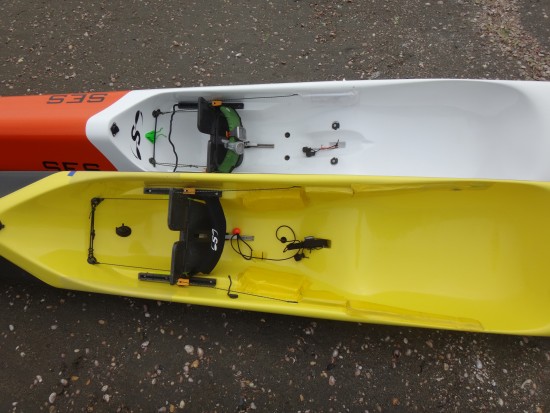
Better shaped bucket, no padding needed. 3 point footplate with cam locks, another 1st in industry.
4. Narrowed catch area significantly to enhance paddle stroke efficiency by a more vertical blade placement provided your paddling technique allows for this.
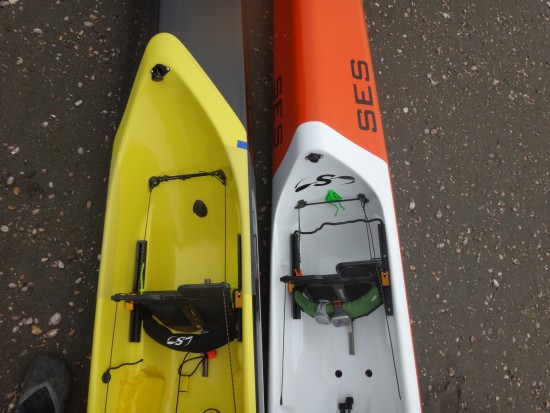
Catch narrowed significantly, and space taken out forward of footwell, peaked deck. Curved transition from footwell to foredeck strengthens ski.
5. Less space in front of footwell to facilitate better draining and visually more appealing.
6. Peaked deck to shed water better.
7. Two venturi drains to facilitate better draining.
8. Carbon bow and aft handles and water bottle holder for convenience.
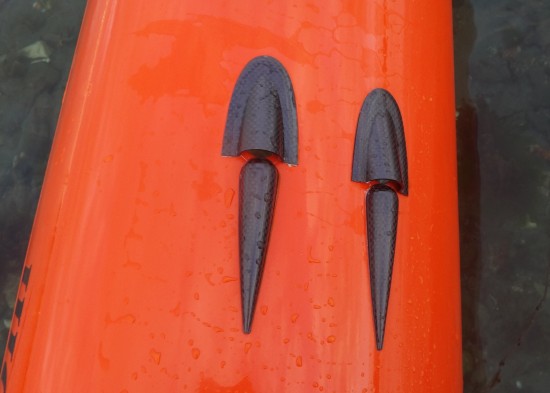
Improved draining with 2 venturis
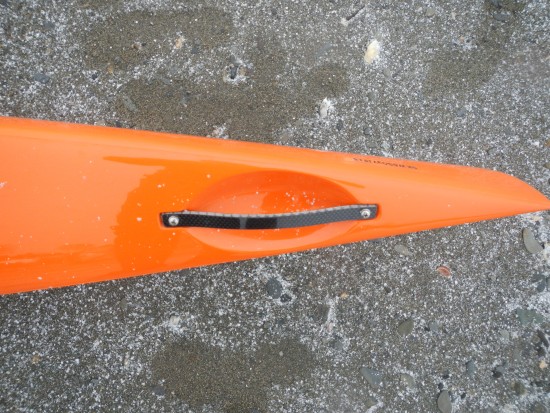
Roomy indentation with carbon handles for better transport and tie down
My thoughts on the SES 2G.
Reviewing of Surf Skis
Currently I have raced and paddled the new SES Excel layup at 24lbs and the Advantage Layup at 31lbs. Because I have had the SES since January, I would normally have much more bucket time, but due to the severe Northeast winter, I was mainly limited to flat water paddling. I initially started paddling the SES 2G with the 9 inch rudder and then transitioned to the 8 inch which I continue to use now. I have raced it on flat water, Run of the Charles on a so/so day for me. My next race will be the Sakonnet River Race which is where I do all my time trials for all my boats. https://surfskiracing.org/surfskiamerica/ See the link for all the results since 2008 on Surfski America by clicking on the “Table” tab and going to the Sakonnet River Race. My time trials are done on parts of this course. I have GPS data dating back to 2003 when I began my journey trying to find the “perfect surf ski”. You can look back at some of my other reviews to see how much data I have aquired on the boats I have reviewed. Within this review for the first time, I have more data that I have shared with you: 4 video clips, 6 Garmin links to my GPS data, and a head to head comparison of three distinct skis.
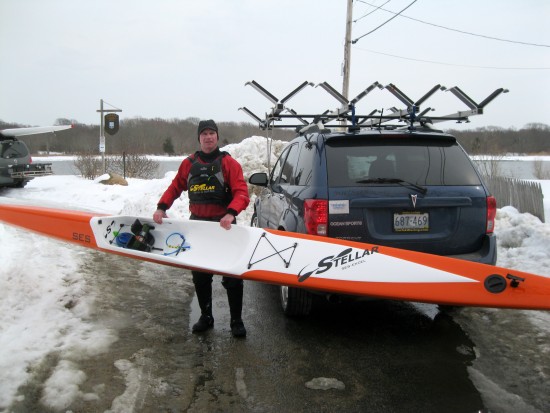
Narrow River Training w/4 inch rudder
Having paddled many surf skis, I can quickly assess a surf ski within a few minutes of paddling it. However, I realize over the year’s, more time in the bucket is needed to fairly address the characteristics of a particular surfski. You also have to be attuned to the subtle differences of handling and performance. So unlike the casual reviewers, I like to have three reference points or benchmarks when reviewing a surf ski for speed: (1) Repeatable time trial courses(since 2003), (2)training sessions with my long time training partners(5-10 years), and races. For this review as mentioned earlier, I have less races but will add my future races to this post. I also like to assess stability in different waters including not only the Sakonnet (small bay conditions) ,but Jamestown waters where we host the Ride The Bull Race and the Double Beaver Race. Both of these races famous in New England for very confused conditions that rival any conditions we hold here on the Northeast SurfskiRacing.com Circuit. Note, I can only review the boats in the conditions I have available to me. Rhode Island has a great variety of waters for testing surfskis. We don’t have a lot of true big downwind. I don’t apologize for that. As I say often to paddlers, “we are all products of the waters we train in”. The popularity of surf skis is they are so versatile on flat water (lakes,rivers,inlets) or ocean conditions.
Also of note, I realized while paddling in Virginia Beach a few weeks ago, that warm water paddlers have such an advantage over us in the frigid waters of the Northeast. Warm water paddlers care much less about capsizing then we do. The mental strain of being tossed into cold water at any given point is what we have grown accustom to. But I realized what a relief it was not to worry about capsizing enabling me to fully enjoy the aspects of paddling. I relate this to doing surf ski reviews in that I care much more about the stability of skis, than I think I would if I lived in a warmer part of the USA. On the upside, this attention to the stability of skis, has enabled me to become acutely aware of the surfski differences. Just food for thought for the warm water paddlers reading this.
Below is a video paddling my SES 2G with 8 inch rudder that I shot a few weeks ago. I wanted you to get a feel of where I time trial all my surf skis. This is also the Sakonnet River Race 12 mile course that is June 6th, 2015, 10 am that I refer to earlier on Surfski America. The Sakonnet is a perfect place to time trial skis since I can go North for more flat water time trials like the Pier to Pier Course (.25 miles), Island Park Course (3 miles) or South to Sandy Point (1.63 miles), to Black Point (3.2 miles), 3rd Rock (5.5 miles), Sakonnet River Race Course (12 miles). All courses are one way distances with the exception of the 12 mile Sakonnet River Race Course. The Sakonnet is small bay conditions leading to true ocean conditions on the bigger days especially past Black Point.
New Stellar 2015 SES with Wesley Echols on Sakonnet River from Wesley Echols on Vimeo.
Fit
The fit while personal to every paddler, is one of the features I like the most on the SES 2G. The rounded bucket and slightly narrower width, fits me to a tea with no padding in the hips needed. For summer paddling I added 1/4 inch calf pads to keep my legs in an even better leg position. For winter paddling with all my cold water gear on, I use no calf pads. The SES will fit paddlers with hips(not waist) of approximate 4o inches and below. I remind everyone that tiny adjustments to fit in these very narrow skis makes a HUGE difference. So experiment with the foot plate length for the perfect fit(not too high-unstable or too cramped), not too low(less leg drive). Be conscious of the what shoes you are wearing(summer or winter) as this alters the knee height. Also you must adjust the toe pedal angle and then readjust. What may feel great on flat water or at a demo may be very different in the ocean. Appropriately placed padding can be the difference in a good fit to a PERFECT fit. So duct tape in some padding, then paddle the ski for 3 or 4 times, then readjust. Experiment with all these things. In novice and intermediate skis these things are very important, however, in a high performance ski (HPS) they are critical to your success in mastering a HPS.
In my SES 1G I have it padded out from the hips down to the my calves as seen in the pictures. The redesigned SES 2G bucket shape promotes hip rotation and leg drive. I now have much better leg drive that feels very intuitive in the new SES. The SES 2G feels like some of the other HPS with its greatly reduced catch area, more K1 like. Historically, Stellars have had low hump heights that allows both short(me) and tall paddlers not to worry about their calves bottoming out on the hump.
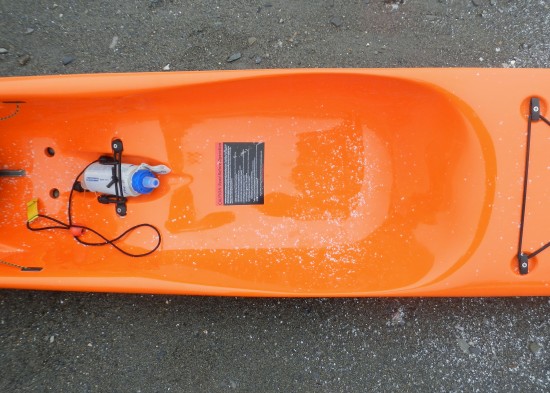
Rounded, better shaped bucket. Bottle holder.
Stability
Just a reminder to the new reader, that the SES is a high performance ski (HPS) for the advanced paddler in ocean conditions. With a greatly narrowed catch, some of the flare was removed from the 2G that gave the SES 1G some of its stability while still owning claim to the most narrow beam of any ocean ski. In the SES 2G, the over hull shape remains virtually unchanged with the exception above. This change however, leads to a different feel in the 2G, where it feels settled and controlled, depending on your skill level. The older SES feels a little loose with more steering input needed, though the secondary stability is plentiful for the advanced paddler. The 2G does has decreased stability in comparison to the 1G, but it maintains the same Stellar predictability in regards to roll rate. The SES 2G tracks much better downwind and feels more planted in the small downwind conditions. It tracks so well, I was able to ride wash with much less effort while shadowing Chris(V14) on a typical downwind day on the Sakonnet. I was locked in on his side wash as he and I mixed it up from Black Point back to McCorrie a few weeks ago. Conditions on the beam and quartering will take more bucket time to adjust over the old SES but it feels solid once you get accustomed to its movement. I remind paddlers that it takes a few months of consistent paddling to get a new surf ski dialed in.
Speed
The speed between the new and old SES is very similar as you can see from my GPS time trials below. I have massive amounts of race data, time trial data, and training GPS data on my SES 1G and this snap shot of a few months, indicates the new SES is at least as fast in the flat to very moderate conditions. As I race the new SES more this season, I will have more race data. I get better leg drive in flat to moderate conditions in the new SES therefore generating more power, while I am currently more stable overall in the older SES. One noticeable difference is that the new 2015 SES does drop into a wave more quickly than the older one. However, I don’t think it climbs out of the trough quite as quickly. The older SES rarely has its bow buried and then only momentarily. The 2015 SES’s design moved the cockpit slightly forward along with the rudder, therefore it’s bow is more planted at all times which allows for much better tracking and downwind maneuvering. The older SES skims from wave to wave but takes much more rudder input going downwind. Not addressed in the time trials are the effect of wash-riding. This would be a big advantage while racing over the old SES. The ability to hop on a wash and stay on or catch smaller bumps with less effort adds up over the course of a race.
It should be noted that I almost always use an 8 inch rudder except for pure flat water(4 inch) with my older SES’s and on occasion the 9 inch rudder. So as you can see, there are some trade offs.
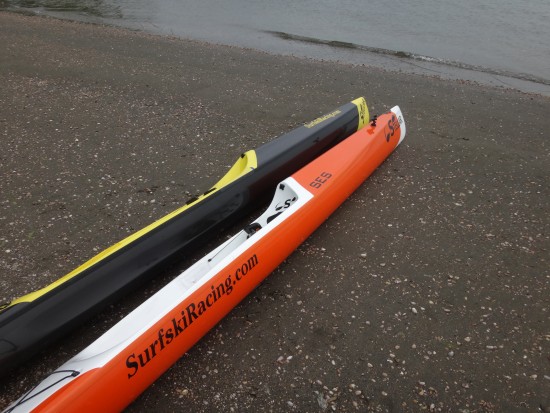
2011 Pre Preg Uni-directional Carbon at 22 lbs. Stellar was first surf ski manufacturer and only one to date to mass produce at reasonable cost.
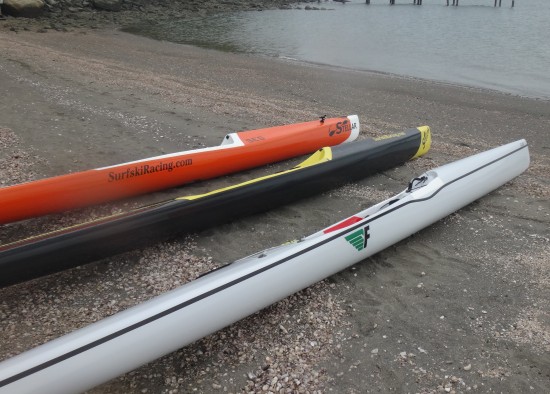
SES 2015, SES 2011, 2014 Glide w/altered lower hump
While paddling the new designed 2015 SR and the SES 2G this winter/spring, I had not paddled my SES 1G that often, so I thought I needed to time trial them back to back with another HPS, my labeled vacuum carbon Glide. The Glide which I reviewed last summer, needed a seat pad so my calves would not bottom out on the too high hump. With limited inquires while listing it for sale, I decided to have the hump professionally lowered by local boat repair expert, Sean Horrigan, to increase its overall stability. I was excited to paddle the Glide with the lowered hump for the first time since last fall in my head to head time trials with the SES’s as another reference point.
This particular time trial(pier to pier) I have done hundreds of times. I typically do this short (.26 mile) course to get a quick sense of how fast a ski is, before I turn to the longer time trials. Last Sunday, I was very tired, having logged 5 days of consecutive paddles ranging from 3 miles to 14 mile training sessions. My heart rate was low since I was very tired and only started to climb on the last two intervals. When viewing the times, you must click on the SPLIT or LAP times to see the intervals on the Garmin page located near the bottom of the pages. I paddled the SES 2G Excel first, then the SES 1G Ultra, then the Glide with two minutes rest between corresponding intervals(w/current and against) before switching skis. I took a 11 minutes rest between my SES 1G Ultra and the Glide to get reaquainted with the Glide. Below are some of my GPS data since January 2015. You can see that the times between all three boats is virtually identical in the head to head intervals. My other GPS times of the SES 2G are very similar to the 1G though the 2G subjectively feels faster. As my stability improves in the SES 2G, my times will improve also.
Time Trials and Race GPS Data
UPDATED: June 14, 2015
My prediction came true. I had my best time ever in any ski on my 3.2 mile course(Black Point to McCorrie), averaging 8.0 mph for that distance.
https://connect.garmin.com/modern/activity/804334166
May 25th, Pier to Pier (.26 miles back to back intervals)
1st 2015 2015 Excel w/8inch rudder: first lap, 3rd lap w/ 2 min rest in between.
2nd 2011 SES Ultra w/8inch rudder: 5th lap,and 7th lap w/2 min rest in between.
Then 11:51 rest(lap 8) to get adjusted to Glide’s new fit.
3rd 2014 Glide with lowered hump with 8 inch rudder: Lap 9 and Lap 11 w/2min rest in between.
https://connect.garmin.com/modern/activity/784681927
March 31st Pier to Pier in SES 2015: You can see I am in the same range 2.11 and 2:20
https://connect.garmin.com/modern/activity/734353715
Sandy Point to McCorrie Point Time Trials
https://connect.garmin.com/modern/activity/782629072
https://connect.garmin.com/modern/activity/764878213
https://connect.garmin.com/modern/activity/739411783
Essex River Race(flat water) w/4 inch rudder
https://connect.garmin.com/modern/activity/776300115
Videos
2015 Essex River Race by Wesley Echols from Wesley Echols on Vimeo.
New Stellar SES with Wesley Echols from Wesley Echols on Vimeo.
Pier to Pier interval above on another day.
2015 Stellar SES Early Season Flatwater Training from Wesley Echols on Vimeo.
Summary
The new redesigned SES 2G is still a HPS for the advanced ocean paddler or intermediate flat water paddler with much improved handling and tracking while providing a very narrow catch similar to other HPS on the market. The rounded bucket and increased taper from the calf area to the foot plate, improves the fit and paddling ergonomics for the small to mid size paddler. The speed is virtually the same as the 1G SES in my time trials. I believe with more bucket time my speeds will improve in the 2G. This speed ranks the SES 2G as still one of the fastest skis on the market. The stability is less than the 1G though it feels very planted most noticeable in downwind conditions and wake riding. The construction quality of Stellar’s continue to be the market leader in my experience of having owned, paddled, and sold many, many different Stellar surfskis over the past six years. The weights on the Ultra’s and Excel layups are the lightest,most robust, on the market, across comparable brand layups. So if you are a small to medium size paddler with advanced ocean skills then the SES 2G is a great option. Conversely, if you are an intermediate or advanced flat water paddler, the SES 2G makes a wonderful flat water racing machine with superb wake riding capabilities, pin point steering, K1 like catch, with an excellent shaped flat water 4 inch rudder.
Strengths (1-5 with 5 being the best) in category of High Performance Skis
- Construction +++++
- Value +++++
- Cockpit shape and taper +++++
- Narrow Catch +++++
- Steering +++++
- Downwind tracking/wash riding +++++
- Ability to drop in on wave +++++
- Speed +++++
- Draining +++
- Stability +++
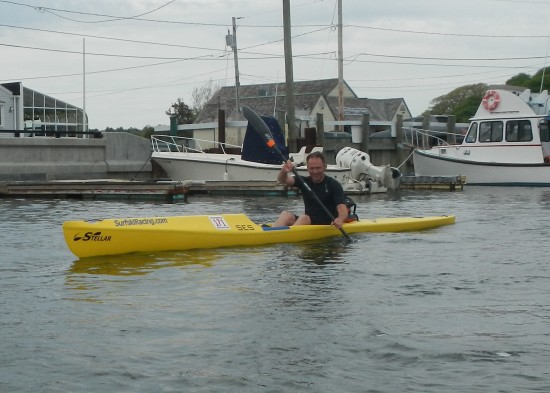
Hugh Pritchard, May 16, 2015. Hugh’s first time in New 2015 SES with a 2nd place finish in highly competitive Essex River Race.
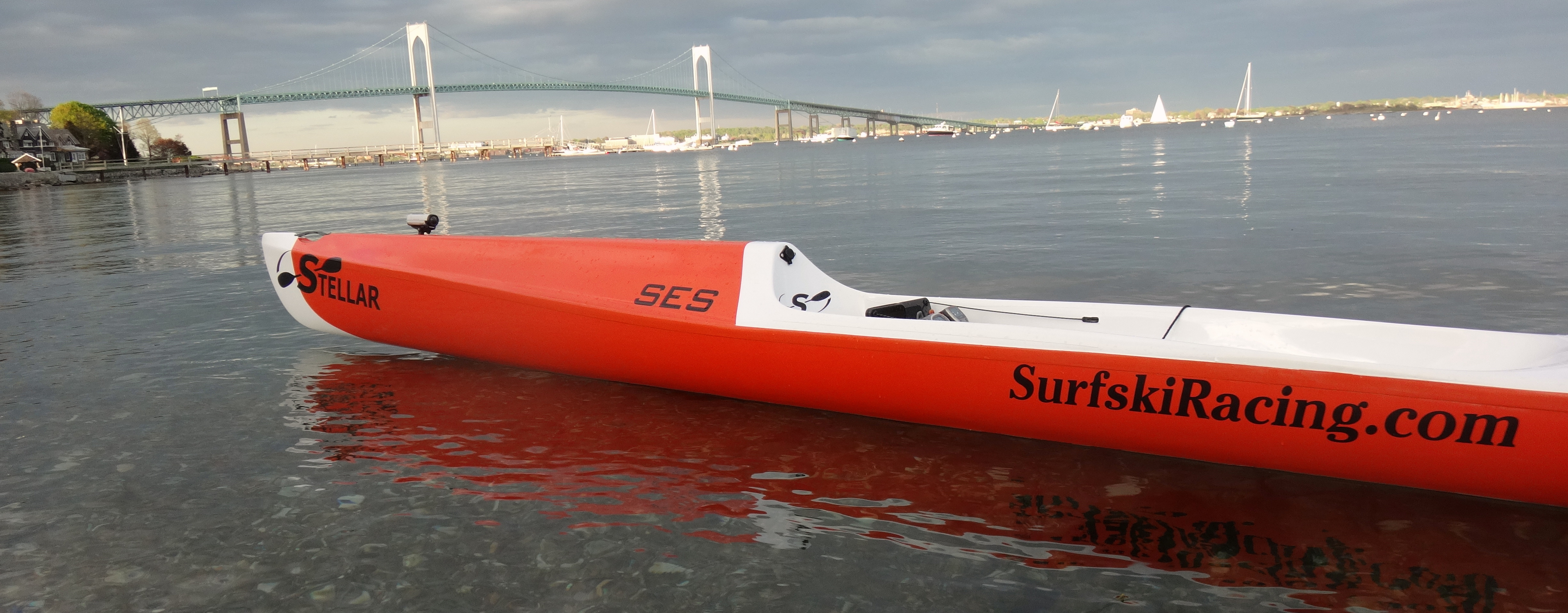
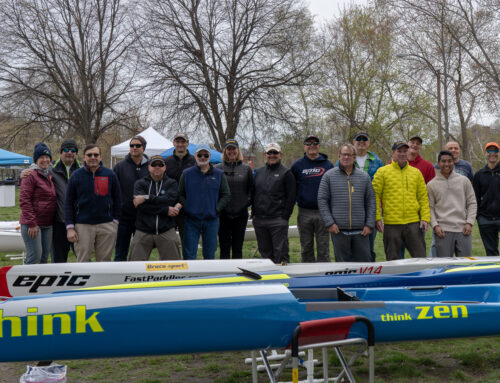
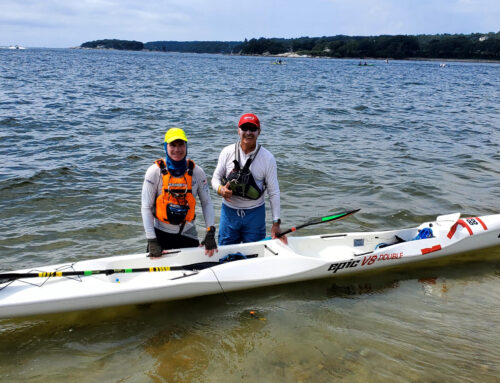
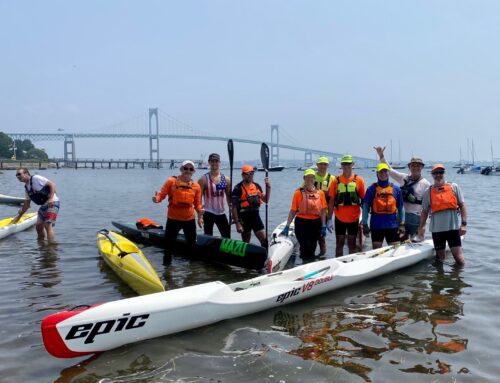
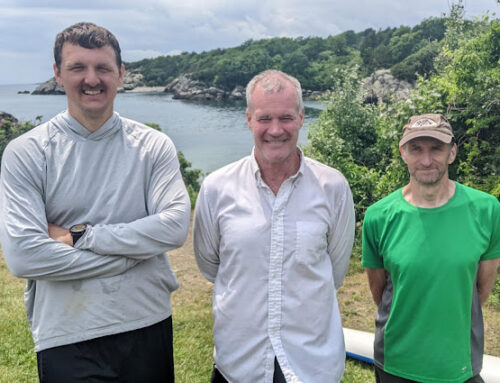
Leave A Comment
You must be logged in to post a comment.